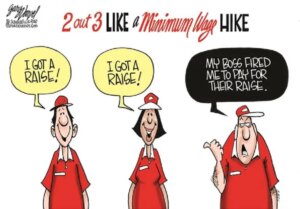The Rising Tide of California’s Minimum Wage: A Double-Edged Sword

In January 2025, California is set to raise its minimum wage to $16.50 per hour. Some cities, like Los Angeles, are already pushing the limit to $19. This significant shift is part of a broader trend that has seen certain groups of workers, notably in the hospitality and airport sectors, climb the pay ladder dramatically. But what does this mean for the economy and employment landscape in the Golden State?
A Closer Look at the Minimum Wage Surge
Hotel and airport workers will see their pay bumped to $22.50 per hour, with projections to reach $30 by 2028. Alongside this pay rise, employers will be mandated to provide an $8.35 per hour healthcare stipend by mid-2026. This translates to an astounding 69% payroll increase for low-skilled positions in just two months. As the Hotel Association of Los Angeles warns, “No industry can afford that financial uptick in such a short period of time.”
The backdrop is troubling. With hotel occupancy still lingering at only 79% of pre-pandemic levels, California’s hospitality sector has already shed thousands of jobs. As the city prepares for the 2028 Olympics, the proposed wage hikes threaten not only existing jobs but also the entire hotel industry’s viability.
The Domino Effect on Employment
“The disparity in pay scales raises a critical question: Should hotel workers earn more than educators?” Such questions circle within business discussions as economic norms are flipped upside-down. Companies are contemplating drastic measures, including layoffs and automation, simply to manage soaring wage costs.
Jon Bortz, CEO of Pebblebrook Hotel Trust, shared, “We are seriously considering converting one of our hotel’s restaurants to a self-service breakfast model.” Such decisions may prevent the immediate job losses, but they underscore a larger crisis in the labor market.
The Role of Lobbying and Politics
The context behind these changes also cannot be ignored. The fast-food sector received notable legislative attention when a bill passed allowing workers in chains with over 100 locations to earn a minimum of $22 per hour. Interestingly, certain establishments, particularly bakeries like Panera Bread, cleverly navigated legislative loopholes to avoid these requirements.
Glenn Flynn, a fast-food mogul and noted donor to Governor Gavin Newsom, has influenced these policies—illustrating how political contributions can sway legislation in favor of particular industries.
Economic Discrimination and Instability
By setting unequal pay practices across various sectors, California’s approach reeks of economic discrimination, manufacturing instability in the labor market. The inconsistency in wage hikes not only accelerates inflation but also forces small and mid-sized businesses into corners they can’t escape—leading to increased prices or diminished working hours.
Experts at the Extreme Investor Network believe this wave of minimum wage hikes devoid of a corresponding increase in productivity will stoke inflationary pressures. It forces businesses to make tough choices, ultimately harming the very workers these regulations aim to assist.
The Road Ahead
As California’s minimum wage figures continue to rise, businesses and workers alike must brace themselves for a turbulent future. The blend of political maneuvering and economic pressure creates an unstable environment where real people—workers, business owners, and consumers—will feel the pain most acutely.
Navigating these changes requires strategic foresight. Extreme Investor Network encourages all stakeholders to engage in conversations about sustainable economic practices. Only through informed dialogue can we find pathways that support both fair wages and healthy economic growth.
For more in-depth analysis on economic trends and impacts, stay connected with Extreme Investor Network as we continue to investigate the complexities of today’s dynamic economic landscape.

